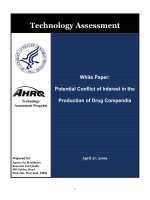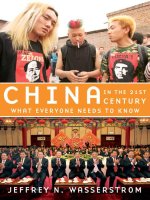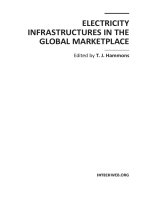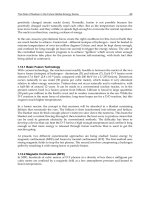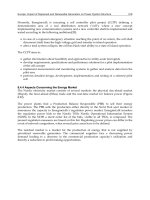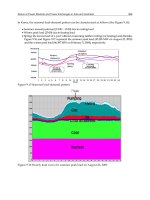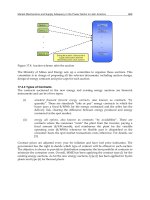Ozren Ocic Oil Refineries in the 21st CenturyOil phần 1 doc
Bạn đang xem bản rút gọn của tài liệu. Xem và tải ngay bản đầy đủ của tài liệu tại đây (117.65 KB, 15 trang )
Ozren Ocic
Oil Refineries in the 21st Century
Oil Refineries. O. Ocic
Copyright ª 2005 WILEY-VCH Verlag GmbH & Co. KGaA, Weinheim
ISBN: 3-527-31194-7
Further Titles of Interest
K. Sundmacher, A. Kienle (Eds.)
Reactive Distillation
Status and Future Directions
2003
ISBN 3-527-30579-3
Wiley-VCH (Ed.)
Ullmann’s Processes and Process Engineering
3 Volumes
2004
ISBN 3-527-31096-7
Wiley-VCH (Ed.)
Ullmann’s Chemical Engineering and Plant Design
2 Volumes
2004
ISBN 3-527-31111-4
T. G. Dobre, J. G. Sanchez Marcano
Chemical Engineering
Modelling, Simulation and Similitude
2005
ISBN 3-527-30607-2
J. Hagen
Industrial Catalysis
A Practical Approach
2005
ISBN 3-527-31144-0
Ozren Ocic
Oil Refineries in the 21st Century
Energy Efficient, Cost Effective, Environmentally Benign
Dr. Ozren Ocic
NIS-Oil Refinery Pancevo
Spoljnostarcevacka b. b.
26 000 Pancevo
Serbia
All books published by Wiley-VCH are carefully
produced. Nevertheless, authors, editors and
publisher do not warrant the information contained
in these books, including this book, to be free of
errors. Readers are advised to keep in mind that
statements, data, illustrations, procedural details
or other items may inadvertently be inaccurate.
Library of Congress Card No.:
applied for
British Library Cataloguing-in-Publication Data:
A catalogue record for this book is available from
the British Library.
Bibliographic information published by
Die Deutsche Bibliothek
Die Deutsche Bibliothek lists this publication in
the Deutsche Nationalbibliografie; detailed
bibliographic data is available in the Internet at
ª 2005 WILEY-VCH Verlag GmbH & Co. KGaA,
Weinheim
All rights reserved (including those of transla tion
in other languages). No part of this book may be
reproduced in any form – by photoprinting, mi-
crofilm, or any other means – nor transmit ted or
translated into machine language without written
permission from the publishers.
Registered names, trademarks, etc. used in this
book, even when not specifically marked as such,
are not to be considered unprotected by lax.
Composition Mitterweger & Partner GmbH,
Plankstadt
Printing Strauss GmbH, Mo¨rlenbach
Bookbinding Litges & Dopf Buchbinderei GmbH,
Heppenheim
Cover Design Gunther Schulz, Fußgo¨nheim
Printed in the Fed eral Republic of Germany.
Printed on acid-free paper
ISBN 3-527-31194-7
Table of Contents
Preface IX
1 Introduction 1
2 Technological and Energy Characteristics of the Chemical Process Industry 5
2.1 Possibilities for Process-Efficiency Management Based on Existing
Economic and Financial Instruments and Product Specifications in
Coupled Manufacturing
6
2.2 Importance of Energy for Crude-Oil Processing in Oil Refineries 8
3 Techno-economic Aspects of Efficiency and Effectiveness of an Oil Refinery 11
3.1 Techno-economic Aspects of Energy Efficiency and Effectiveness in an Oil
Refinery
13
3.2 Techno-economic Aspects of Process Efficiency and Effectiveness in an Oil
Refinery
15
4 Instruments for Determining Energy and
Processing Efficiency of an Oil Refinery
21
4.1 Instruments for Determining Energy and Processing Efficiency of Crude
Distillation Unit
25
4.1.1 Technological Characteristics of the Process 25
4.1.2 Energy Characteristics of the Process 27
4.1.3 Determining the Steam Cost Price 29
4.1.4 Energy Efficiency of the Process 30
4.1.5 Refinery Product Cost Pricing 32
4.2 Instruments for Determining Energy and Processing Efficiency of Vacuum-
distillation Unit
38
4.2.1 Technological Characteristics of the Process 38
4.2.2 Energy Characteristics of the Process 39
4.2.3 Determining the Steam Cost Price 41
4.2.4 Energy Efficiency of the Process 42
4.2.5 Determining the Refinery Product Cost Prices 44
4.3 Instruments for Determining Energy and Processing Efficiency of Vacuum-
residue Visbreaking Unit
50
Oil Refineries. O. Ocic
Copyright ª 2005 WILEY-VCH Verlag GmbH & Co. KGaA, Weinheim
ISBN: 3-527-31194-7
V
4.3.1 Technological Characteristics of the Process 50
4.3.2 Energy Characteristics of the Process 50
4.3.3 Determining the Steam Cost Price 53
4.3.4 Energy Efficiency of the Process 55
4.3.5 Determining the Refinery Product Cost Prices 57
4.4 Instruments for Determining Energy and Processing Efficiency of Bitumen
Blowing Unit
60
4.4.1 Technological Characteristics of the Process 60
4.4.2 Energy Characteristics of the Process 63
4.4.3 Determining the Steam Cost Price 65
4.4.4 Energy Efficiency of the Process 66
4.4.5 Determining Refinery Product Cost Prices 68
4.5 Instruments for Determining Energy and Processing Efficiency of Catalytic
Reforming Unit
69
4.5.1 Technological Characteristics of the Process 69
4.5.2 Energy Characteristics of the Process 70
4.5.3 Determining the Steam Cost Price 72
4.5.4 Energy Efficiency of the Process 72
4.5.5 Determining the Refinery Product Cost Prices 75
4.6 Instruments for Determining Energy and Processing Efficiency
of Catalytic Cracking Unit
79
4.6.1 Technological Characteristics of the Process 81
4.6.2 Energy Characteristics of the Process 82
4.6.3 Determining the Steam Cost Price 85
4.6.4 Energy Efficiency of the Process 87
4.6.5 Determining the Refinery Cost Prices 89
4.7 Instruments for Determining Energy and Processing Efficiency
of Gas Concentration Unit
94
4.7.1 Technological Characteristics of the Process 95
4.7.2 Determining the Refinery Product Cost Prices 96
4.8 Instruments for Determining Energy and Processing Efficiency of Jet-fuel
Hydrodesulfurization Unit
99
4.8.1 Technological Characteristics of the Process 99
4.8.2 Energy Characteristics of the Process 103
4.8.3 Determining the Steam Cost Price 103
4.8.4 Energy Efficiency of the Process 105
4.8.5 Determining the Refinery Product Cost Prices 106
4.9 Instruments for Determining Energy and Processing Efficiency of Gas-Oil
Hydrodesulfurization Unit
108
4.9.1 Technological Characteristics of the Process 108
4.9.2 Energy Characteristics of the Process 109
4.9.3 Determining the Steam Cost Price 110
4.9.4 Energy Efficiency of the Process 112
4.9.5 Determining the Refinery Product Cost Prices 114
Table of ContentsVI
4.10 Instruments for Determining Energy and Processing Efficiency of
Alkylation Unit
116
4.10.1 Technological Characteristics of the Process 116
4.10.2 Energy Characteristics of the Process 117
4.10.3 Determining the Steam Cost Price 118
4.10.4 Energy Efficiency of the Process 120
4.10.5 Determining the Refinery Product Cost Prices 122
5 Blending of Semi-Products into Finished Products and Determining
Finished Product Cost Prices
129
6 Management in the Function of Increasing Energy and Processing
Efficiency and Effectiveness
135
6.1 Management in the Function of Increasing Energy Efficiency and
Effectiveness
135
6.2 Management in the Function of Increasing Processing Efficiency and
Effectiveness
138
6.2.1 Monitoring the Efficiency of Crude-oil Processing Through the System of
Management Oriented Accounting of Semi-Product Cost Prices
139
6.2.2 Management Accounting in the Function of Monitoring the Main Target of
a Company – Maximising Profit through Accounting System of Finished-
Product Cost Prices
142
6.2.3 Break-Even Point as the Instrument of Management System in the Function
of Making Alternative Business Decisions
144
References 150
Subjekt Index 153
Table of Contents VII
Preface
The increasing competition among the oil refineries of the world, which results in
fewer and larger installations, calls for a clear understanding of the economics and
the technological fundamentals and characteristics.
According to its basic function in the national energy system, the oil-processing
industry actively participates in attaining the objectives of energy and economy policy
at all levels of a society. In many national economies today, oil derivatives participate in
more than one third of the final energy consumption, the same as crude oil in available
primary energy. This proves that oil and its derivatives are still among the main pillars
of national industry, and the oil-processing industry one of the main branches in en-
ergetics, despite all the efforts to limit the application of liquid fuels for thermal pur-
poses, considering the need to limit the import of crude oil.
In addition to being one of the main energy generators, and a significant bearer of
energy in final use, oil-processing industry is at the same time a great energy consu-
mer. The importance of the oil-processing industry as one of the main pillars of na-
tional energetics, obligates it to process oil in a conscientious, economical way. The
mere fact that oil refineries mostly use their own (energy-generating) products does
not free them from the obligation to consume these energy carriers rationally. Rational
consumption of oil derivatives should start at the very source, in the process of deri-
vative production, and it should be manifested in a reduction of internal energy con-
sumption in the refineries. The quantity of energy saved by the very producer of energy
will ensure the reduction in the consumption of primary energy in the amount that
corresponds to the quantity of the produced secondary energy.
From the aspect of a rational behaviour towards the limited energy resources, the oil-
processing industry should be treated as a process industry that uses considerable
quantities of energy for the production. The mere fact that these products are oil de-
rivatives, i.e. energy carriers, does not affect the criteria for rational behaviour. In that
sense, oil processing industry is treated in the same way as the other process industries
from non-energy branch.
The book gives a detailed practical approach to improve the energy efficiency in
petroleum processing and deals with the role of management and refinery operators
in achieving the best technological parameters, the most rational utilization of energy,
as well as the greatest possible economic success.
Oil Refineries. O. Ocic
Copyright ª 2005 WILEY-VCH Verlag GmbH & Co. KGaA, Weinheim
ISBN: 3-527-31194-7
IX
I would like to express my gratitude to Prof. Dr. Siegfried Gehrecke and Dr. Bozana
Perisic, both long-time colleagues, who greatly contributed with their professional
knowledge to the quality of this book. I would also like to thank Dr. Hubert Pelc
of Wiley-VCH and all other staff involved, who made this book available to oil industry
experts from all over the world, as well as to those having similar aspirations.
Pancevo, September 2004 Ozren Ocic
PrefaceX
1
Introduction
In the early 1970s, it was clear that the world economy was facing recession and that
the four-fold increase in crude-oil prices by OPEC, a monetary crisis, and inflation
were the main reasons for such a trend. The four-fold increase in crude-oil prices
in 1974, which was intensified in 1979, is why 1974 and 1979 are called the years
of “the first” and “the second crude-oil shock”, respectively. Increases in crude-oil
prices had an effect on all importing countries, more precisely on their economic
development. This effect depended on the quantity of oil that was being imported
and on the possibility of substituting liquid fuel with solid fuel or some alternative
forms of energy. The fact remains that oil-importing dependence in developed coun-
tries varied, ranging from some 20 % in the USA, for example, up to 100 % in Japan,
and this was how the increase in crude-oil prices that affected developed countries was
interpreted differently, starting from “crude-oil illusions” to “sombre prospects”, de-
pending on who was giving the interpretation.
However, in underdeveloped countries, the effects of the rise in crude-oil prices
were unambiguous, especially in the countries that lacked both oil and money,
and were forced to solve their energy problems by way of import.
When commenting on economic trends and making forecasts, it became customary
after each increase in crude-oil and oil-product prices, to predict to what percentage
this increase would affect monthly, and therefore annual, inflation. Considering that
crude oil has priority in the energy–fuel structure and that oil-product prices in the
course of the 1970s and 1980s increased up to twenty times in comparison with the
base year – 1972, it became clear that energy was the main cause of inflation.
The fact that economic policy subjects in all those years, had not taken measures to
decrease the share of imported energy in the domestic energy consumption, supports
the assumption that they attributed much greater importance to demand inflation than
to cost inflation.
The compound word “stagflation”, representing the combination of two words
“stagnation + inflation”, was related to demand inflation that, being accompanied
by the stagnation in economic development, presented the most difficult form of eco-
nomic crisis and in accordance with that the suggested measures were directed to-
wards decreasing the demand inflation, i.e. decreasing citizen spending capacity.
The arguments against this interpretation are economic theory, on the one hand,
and in practical terms on the other. Namely, economic theory does not accept the
Oil Refineries. O. Ocic
Copyright ª 2005 WILEY-VCH Verlag GmbH & Co. KGaA, Weinheim
ISBN: 3-527-31194-7
11
possibility of a simultaneous apperance of demand inflation and economic-growth
stagnation.
“After World War II, economies were often stagnating, meaning that there was no
surplus in global demand, but the prices continued to increase. Economists call these
situations – stagflation (stagnation + inflation). In situations like these, interpretation
of inflation is complicated. It can no longer be explained by overdemand, but by cost
inflation, or by both together” [1].
In the sphere of cost inflation, the following are stated: spiral of wages and prices,
uneconomic consumption, import costs and sector inflation, and in the sphere of
structural inflation: import substitution, inequality regarding the sector economic po-
sition and foreign trade exchange.
Bearing in mind the crude-oil price trends in the world market, the dependence of
some countries on crude-oil imports and the importance of energetics as a branch with
tremendous external effects, it could be concluded that cost inflation is caused by
imports and that its mechanism is simple. By incorporating the ever more expensive
imported feedstock into product prices, without meaningful attempts to compensate,
at least partially, this cost by internal economy measures, selling prices started to in-
crease. Considering that energetics directly or indirectly contributes to the prices of all
other goods, inflation started to develop. On the other hand, it was proven in practice
that economic-policy measures directed towards decreasing the demand inflation by
decreasing citizen spending capacity have not resulted in an inflation rate decrease,
which leads to the conclusion that it is some other type of inflation, not demand in-
flation.
If this “diagnosis” were accepted, i.e. if it were accepted that it was mostly cost,
psychological and structural inflation rather than demand inflation, it would mean
that adequate “therapy” would have to be accepted as well, that is suitable econom-
ic-policy measures affecting inflation in the mentioned order.
It has been shown in practice that product prices incorporate all the faults and draw-
backs of the internal economy without any significant attempts to find ways to stop the
increase and even cut the prices, by way of a better utilisation of production capacities,
greater productivity, better organisation, etc. Each increase in prices was explained by
the increase in costs, the tendency to eliminate business losses or by the fear from
operating with loss. In the conditions of free price forming, this last argument can
mostly explain the so-called psychological inflation typical of the last couple of
years. All the activities by business subjects were directed towards forecasting and
determining business costs without analysing the cause or finding the possibility
to reduce them by adequate internal economy measures.
This is supported by the fact that in one of the basic economy branches that causes
inflation in all other branches – the oil industry – there are no cost prices either for
semi-products or for products, but only cost calculations per type of costs. Justification
for such a practice can be found in the fact that the feedstock, i.e. crude oil (mostly
imported) has the greatest share in the cost-price structure, and this is something that
the oil industry has no effect on. However, when this problem is more thoroughly
analysed, it can be seen that other costs are not irrelevant either, that great savings
are possible, but also that the crude-oil share in the cost-price structure shows a ten-
1 Introduction2
dency to decrease. For years, efforts were made to prove that it was impossible to
determine cost prices because it was coupled products that were in question and
that it was not possible to distribute the costs per cost bearer.
It is becoming even clearer that a methodology must be established to determine the
cost prices and refinery products, so that by way of actual planning calculations, i.e. by
way of calculations per unique prices (which would eliminate the inflation influence),
refinery business operations could be monitored, by comparing the calculations be-
tween the refineries across the world. In order to make this possible, it is necessary to
select a common methodology that would be improved through practice.
From the aspect of rational power utilization, it must be pointed out that, when
evaluating the total rationality of power utilization in industry, the adopted objectives
of energy and economic policy must present a starting point, as well as the question
whether and to what extent the existing way of utilizing the power contributes to at-
taining these objectives.
In addition to giving priority to domestic instead of imported energy carriers, one of
the objectives of national energy and economy policy is economic, conscientious, and
rational behaviour towards the limited energy resources. This objective is attained by
way of numerous technical, organizational and other measures for rational energy
consumption. The effects of energy-consumption rationalization are mostly mea-
sured by:
– indicators of specific energy consumption per product unit, or
– indicators of specific energy costs per product unit.
Both indicators have their function and complement each other, which indicates
that economical behaviour has its technical and economic effects, which may, but
do not have to, coincide.
According to its basic function in the national energy system, the oil-processing
industry actively contributes to attaining the objectives of energy and economy policy
at all levels of a society. In many national economies today, oil derivatives participate in
more than one third of the final energy consumption, the same as crude oil in available
primary energy. This proves that oil and its derivatives are still among the main pillars
of national industry, and the oil-processing industry is one of the main branches in
energetics, despite all the efforts to limit the application of liquid fuels for thermal
purposes, considering the need to limit the import of crude oil.
In addition to being one of the main energy generators, and a significant bearer of
energy in final use, the oil-processing industry is at the same time a great energy
consumer. The importance of the oil-processing industry as one of the main pillars
of national energetics, obligates it to process oil in a conscientious, economical way.
The mere fact that oil refineries mostly use their own (energy-generating) products
does not free them from the obligation to consume these energy carriers ration-
ally. Rational consumption of oil derivatives should start at the very source, in the
process of derivative production, and it should be manifested in a reduction of inter-
nal energy consumption in the refineries. The quantity of energy saved by the very
producer of energy will ensure the reduction in the consumption of primary energy
in the amount that corresponds to the quantity of the produced secondary energy.
1 Introduction 33
From the aspect of a rational behaviour towards the limited energy resources, the oil-
processing industry should be treated as a process industry that uses considerable
quantities of energy for the production. The mere fact that these products are oil de-
rivatives, i.e. energy carriers, does not affect the criteria for rational behaviour. In this
sense, the oil-processing industry is treated in the same way as the other process in-
dustries from the non-energy branch.
Analysis of the oil-processing industry as a processing industry that uses consider-
able quantities of energy for the production starts, as in all the other industries, energy
consumers, with an analysis of the energy system.
This book deals with the possibility of a rational production and consumption of
energy, thus with a more economical running of business in the oil-processing indus-
try.
1 Introduction4
2
Technological and Energy Characteristics of
the Chemical Process Industry
In the field of industry, as a branch of the economy, specific forms of material pro-
cessing have been developed, marked by changes of chemical properties. Such a meth-
od of production, characterized by chemical changes, and often followed by physical
transformations, is called the process industry. It can be defined as “a group of indus-
try (and mining) sectors in which feedstock is chemically treated for making final
products” [2].
The process technology dealing with industrial feedstock processing, by changing
their structural and physical properties, appeared at the beginning of the twentieth
century, due to the development of the chemical industry, wherein the manufacturing
procedure is a chain of several units. The feedstock in each one is treated in a different
mode, and their aggregate functioning has to be organized in such a way as to achieve
the optimum result, namely to maximize the benefit or profit, to minimize the inputs,
and also to meet other criteria, such as for instance, product quality, requirements of
regional product market, environmental protection, and other possible specific re-
quirements.
Optimum functioning of each separate unit is not always feasible, when aiming at
optimum functioning of the whole combined process plant.
Within the classification of industrial branches, there are some that do not strictly
meet the criterion of predominant chemical changes in the feedstock, but nevertheless
they are looked upon as a part of the process industry, due to additional criteria, mainly
if physical changes are involved.
The main branches in this group of process industry are as follows [3]:
– Electric power,
– Coal mining,
– Petroleum refining,
– Metallurgy of iron and steel,
– Nonferrous metallurgy,
– Non-metal mineral processing,
– Basic chemicals manufacture,
– Processing of chemical products,
– Building material manufacture,
– Manufacture of wood construction materials,
Oil Refineries. O. Ocic
Copyright ª 2005 WILEY-VCH Verlag GmbH & Co. KGaA, Weinheim
ISBN: 3-527-31194-7
55
– Pulp and paper industry,
– Textile fibers and filaments,
– Leather and fur manufacture,
– Rubber processing,
– Food products,
– Manufacture of beverages,
– Tobacco processing,
– Miscellaneous products manufacture.
“When classifying some branches of industry and mining to the field of process
industry, the criterion of chemical transformation, at least in a wider sense, has
been persistently applied. Therefore, for instance, a chemical industry group – plas-
tics processing with subdivisions: production of wrapping material and various plas-
tics – should not be included into the process industry, because in such technologies
they are but physical transformations” [4]. The author of this quotation believes that
the following industrial branches should not be included in the group of process in-
dustry:
– Cattle-food production,
– Fiber spinning,
– Human foodstuffs and grocery production.
All the process-industry branches are characterized by extremely complex techno-
logical procedures; they are materialized in sophisticated production equipment, by
highly trained experts in managing and maintenance activities. Because of such ad-
vanced production processes, the problems of monitoring the technological and en-
ergy efficiency necessarily arise in many cases.
2.1
Possibilities for Process-Efficiency Management Based on Existing Economic
and Financial Instruments and Product Specifications in Coupled Manufacturing
From the aspect of existing business operations efficiency, especially in coupled
production, the possibilities of efficiency management appear to be limited, due to
the development lag of the calculating methods for production costs or product selling
prices, in comparison with the advances in overall economy and specific business
activities.
“Comparing the developments in accounting, especially the improvements in cal-
culating techniques to the advances of technology, one can hardly understand that
calculation as a methodological procedure falls behind the available technical sup-
port. Overcoming this draw-back by paying more attention to the accounting, espe-
cially to the methods and ways in calculation, many errors could be avoided, which
in some cases are a source of big losses” [5].
2 Technological and Energy Characteristics of the Chemical Process Industry6
